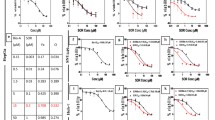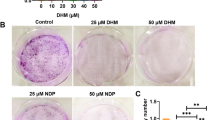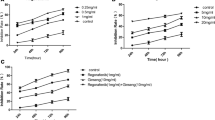Abstract
Hepatocellular carcinoma (HCC) is still a leading cancer killer in the community. Molecular targeted therapy with celecoxib (CXB) has shown promising antitumor effects; however, its use may be limited due to serious side effects. Curcumin (CUR) has also shown beneficial effects against HCC. Then, it was aimed to investigate the effects of adding CUR to CXB on HCC HepG2 cells. HepG2 cells were treated with CXB and/or CUR at increasing concentrations to investigate synergistic drug interactions, as calculated combination index (CI). Combination treatment effects on cell viability and caspase-3 activation were assessed. The levels of Akt, nuclear factor-kappa B (NF-κB), prostaglandin E2 (PGE2), malondialdehyde (MDA), cyclin D1 (CD1), and vascular endothelial growth factor (VEGF) were also evaluated. CXB (3.13–100 μM) and/or CUR (1.25–40 μM) reduced HepG2 cell viability dose-dependently. Nevertheless, lower combined concentrations showed higher synergism (CI < 1) and higher CXB dose reduction index (DRI > 1). Also, the addition of CUR to CXB resulted in increased cytotoxicity and caspase-3 activation, as compared to CXB alone. In addition, the selected combination significantly reduced the levels of Akt, NF-κB, PGE2, MDA, CD1, and VEGF, as compared to either agent alone. In conclusion, CUR augmented the CXB-mediated antitumor effects in HepG2 cells through, at least in part, antiproliferative, antioxidant, and pro-apoptotic mechanisms. This may allow the further use of CXB at lower concentrations, combined with CUR, as a promising safer targeted strategy for HCC management.






Similar content being viewed by others
Abbreviations
- CD1:
-
Cyclin D1
- CI:
-
Combination index
- CUR:
-
Curcumin
- CXB:
-
Celecoxib
- DRI:
-
Dose reduction index
- HCC:
-
Hepatocellular carcinoma
- HepG2:
-
Human liver-derived hepatoma G2
- DMEM:
-
Dulbecco’s modified eagle medium
- FBS:
-
Fetal bovine serum
- IC50 :
-
Median inhibitory concentration
- MDA:
-
Malondialdehyde
- MTT:
-
3-[4, 5-Dimethylthiazol-2-yl]2,5-diphenyltetrazolium bromide
- NF-κB:
-
Nuclear factor kappa B
- p-Akt:
-
Phospho-Akt
- PGE2 :
-
Prostaglandin E2
- SEM:
-
Standard error of the mean
- VEGF:
-
Vascular endothelial growth factor
References
Aggarwal BB, Kumar A, Bharti AC (2003) Anticancer potential of curcumin: preclinical and clinical studies. Anticancer Res 23:363–398
Alao JP (2007) The regulation of cyclin D1 degradation: roles in cancer development and the potential for therapeutic invention Molecular cancer 6:24
Bae SH, Jung ES, Park YM, Kim BS, Kim BK, Kim DG, Ryu WS (2001) Expression of cyclooxygenase-2 (COX-2) in hepatocellular carcinoma and growth inhibition of hepatoma cell lines by a COX-2 inhibitor, NS-398 Clinical Cancer Research 7:1410–1418
Bai D, Ueno L, Vogt PK (2009) Akt-mediated regulation of NFκB and the essentialness of NFκB for the oncogenicity of PI3K and Akt. Int J Cancer 125:2863–2870
Banerjee S et al (2007) In vitro and in vivo molecular evidence for better therapeutic efficacy of ABT-627 and taxotere combination in prostate cancer. Cancer Res 67:3818–3826
Bassiouny AR, Zaky A, Neenaa HM (2010) Synergistic effect of celecoxib on 5-fluorouracil-induced apoptosis in hepatocellular carcinoma patients. Ann Hepatol 9:410–418
Beevers CS, Chen L, Liu L, Luo Y, Webster NJ, Huang S (2009) Curcumin disrupts the mammalian target of rapamycin-raptor complex. Cancer Res 69:1000–1008
Bertagnolli MM et al. (2009) Five-year efficacy and safety analysis of the Adenoma Prevention with Celecoxib Trial Cancer prevention research:1940–6207. CAPR-1908-0206
Bijman MN, Hermelink CA, van Berkel MP, Laan AC, Janmaat ML, Peters GJ, Boven E (2008) Interaction between celecoxib and docetaxel or cisplatin in human cell lines of ovarian cancer and colon cancer is independent of COX-2 expression levels Biochemical pharmacology 75:427–437
Cao J et al. (2007) Curcumin induces apoptosis through mitochondrial hyperpolarization and mtDNA damage in human hepatoma G2 cells Free Radical Biology and Medicine 43:968–975
Cervello M et al (2011) COX-2-dependent and COX-2-independent mode of action of celecoxib in human liver cancer cells Omics. A J Integrative Biology 15:383–392
Cervello M, Bachvarov D, Lampiasi N, Cusimano A, Azzolina A, McCubrey JA, Montalto G (2013) Novel combination of sorafenib and celecoxib provides synergistic anti-proliferative and pro-apoptotic effects in human liver cancer cells. PloS One 8:e65569
Cheng A-L et al (2001) Phase I clinical trial of curcumin, a chemopreventive agent, in patients with high-risk or pre-malignant lesions. Anticancer Res 21:2895–2900
Cheng C-Y, Lin Y-H, Su C-C (2010) Curcumin inhibits the proliferation of human hepatocellular carcinoma J5 cells by inducing endoplasmic reticulum stress and mitochondrial dysfunction. Int J Molecular Med 26:673–678
Chou T-C (2006) Theoretical basis, experimental design, and computerized simulation of synergism and antagonism in drug combination studies. Pharmacological Rev 58:621–681
Chou T, Martin N (2007) CompuSyn software for drug combinations and for general dose-effect analysis, and user’s guide Paramus: ComboSyn Inc
Cui W, Yu C-H, Hu K-Q (2005) In vitro and in vivo effects and mechanisms of celecoxib-induced growth inhibition of human hepatocellular carcinoma cells. Clinical Cancer Res 11:8213–8221
Cui J et al (2014) Cyclooxygenase-2 inhibitor is a robust enhancer of anticancer agents against hepatocellular carcinoma multicellular spheroids. OncoTargets Therapy 7:–353
Cusimano A, Foderà D, D’Alessandro N, Lampiasi N, Azzolina A, Montalto G, Cervello M (2007) Potentiation of the antitumor effects of both selective cyclooxygenase-1 and cyclooxygenase-2 inhibitors in human hepatic cancer cells by inhibition of the MEK/ERK pathway Cancer biology & therapy 6:1457–1464
Darvesh AS, Aggarwal B, Bishayee A (2012) Curcumin and liver cancer: a review. Current Pharmaceutical Biotechnology 13:218–228
Davies NM, McLachlan AJ, Day RO, Williams KM (2000) Clinical pharmacokinetics and pharmacodynamics of celecoxib. Clinical Pharmacokinetics 38:225–242
De Porras VR et al. (2016) Curcumin mediates oxaliplatin-acquired resistance reversion in colorectal cancer cell lines through modulation of CXC-chemokine/NF-κB signalling pathway Scientific reports 6:24675
Domiati S, Ghoneim A (2015) Celecoxib for the right person at the right dose and right time: an updated overview. Springer Sci Rev 3:137–140
Donato MT, Tolosa L, Gómez-Lechón MJ (2015) Culture and functional characterization of human hepatoma HepG2 cells Protocols in In Vitro Hepatocyte Research:77–93
Du Q, Hu B, An H-M, Shen K-P, Xu L, Deng S, Wei M-M (2013) Synergistic anticancer effects of curcumin and resveratrol in Hepa1-6 hepatocellular carcinoma cells. Oncology Reports 29:1851–1858
Duan W et al (2014) Curcumin inhibits hypoxia inducible factor-1α-induced epithelial-mesenchymal transition in HepG2 hepatocellular carcinoma cells. Molecular Med Reports 10:2505–2510
Ekor M, Odewabi AO, Kale OE, Adesanoye OA, Bamidele TO (2013) Celecoxib, a selective cyclooxygenase-2 inhibitor, lowers plasma cholesterol and attenuates hepatic lipid peroxidation during carbon-tetrachloride–associated hepatotoxicity in rats Drug and chemical toxicology 36:1–8
El-Serag HB, Rudolph KL (2007) Hepatocellular carcinoma: epidemiology and molecular carcinogenesis Gastroenterology 132:2557–2576
El-Awady RA, Saleh EM, Ezz M, Elsayed AM (2011) Interaction of celecoxib with different anti-cancer drugs is antagonistic in breast but not in other cancer cells. Toxicology Appl Pharmacology 255:271–286
Elgharably A, Gomaa AI, Crossey MME, Norsworthy PJ, Waked I, Taylor-Robinson SD (2017) Hepatitis C in Egypt—past, present, and future. Int J General Med 10:1–6. https://doi.org/10.2147/ijgm.s119301
Fan H, Tian W, Ma X (2014) Curcumin induces apoptosis of HepG2 cells via inhibiting fatty acid synthase. Targeted Oncology 9:279–286
Feo F, Pascale RM, Calvisi DF (2007) Models for liver cancer. Cancer Handbook 2:1118–1133
Fujisawa S, Atsumi T, Ishihara M, Kadoma Y (2004) Cytotoxicity, ROS-generation activity and radical-scavenging activity of curcumin and related compounds. Anticancer Res 24:563–570
Gan SD, Patel KR (2013) Enzyme immunoassay and enzyme-linked immunosorbent assay. J Invest Dermatol 133:e12
Ghoneim AI (2009) Effects of curcumin on ethanol-induced hepatocyte necrosis and apoptosis: implication of lipid peroxidation and cytochrome c Naunyn-Schmiedeberg's archives of pharmacology 379:47
Ghoneim A (2012) Phytochemicals and amino acids: inducers or inhibitors of cell death? In: Natural compounds as inducers of cell death. Springer, pp 3–32
Ghoneim AI, Eldahshan OA (2012) Anti-apoptotic effects of tamarind leaves against ethanol-induced rat liver injury. J Pharmacy Pharmacology 64:430–438
Ghoneim AI, Abdel-Naim AB, Khalifa AE, El-Denshary ES (2002) Protective effects of curcumin against ischaemia/reperfusion insult in rat forebrain. Pharmacological Res 46:273–279
Goel A, Boland CR, Chauhan DP (2001) Specific inhibition of cyclooxygenase-2 (COX-2) expression by dietary curcumin in HT-29 human colon cancer cells. Cancer Letters 172:111–118
Gong SJ, Jin CJ, Rha SY, Chung HC (2004) Growth inhibitory effects of trastuzumab and chemotherapeutic drugs in gastric cancer cell lines. Cancer Letters 214:215–224
Gong L, Thorn CF, Bertagnolli MM, Grosser T, Altman RB, Klein TE (2012) Celecoxib pathways: pharmacokinetics and pharmacodynamics. Pharmacogenetics Genomics 22:310
Grösch S, Maier TJ, Schiffmann S, Geisslinger G (2006) Cyclooxygenase-2 (COX-2)–independent anticarcinogenic effects of selective COX-2 inhibitors. J National Cancer Institute 98:736–747
Harris R (2009) Cyclooxygenase-2 (cox-2) blockade in the chemoprevention of cancers of the colon, breast, prostate, and lung. Inflammopharmacology 17:55–67
Hawk ET, Viner JL, Dannenberg A, DuBois RN (2002) COX-2 in cancer—a player that's defining the rules. Oxford University Press,
Hood WF, Gierse JK, Isakson PC, Kiefer JR, Kurumbail RG, Seibert K, Monahan JB (2003) Characterization of celecoxib and valdecoxib binding to cyclooxygenase. Molecular Pharmacology 63:870–877
Hu Z, Jiang K, Chang Q, Zhang Y, Zhou B, Zhang Z, Tao R (2017) Effect of talin1 on apoptosis in hepatoma carcinoma cells via the PI3K/Akt/NF-κB signaling pathway. RSC Advances 7:40179–40188
Huang C-H, Guh J-H, Chen GS, Lu P-H, Chern J-W (2010) Anticancer activity of a cyclooxygenase inhibitor, CX9051, in human prostate cancer cells: the roles of NF-κB and crosstalk between the extrinsic and intrinsic apoptotic pathways. Naunyn-Schmiedeberg’s Archives Pharmacology 382:159–169
Kane LP, Shapiro VS, Stokoe D, Weiss A (1999) Induction of NF-κB by the Akt/PKB kinase. Current Biology 9:601–S601
Kerr JF, Wyllie AH, Currie AR (1972) Apoptosis: a basic biological phenomenon with wideranging implications in tissue kinetics. British J Cancer 26:239
Khalil MI, Ibrahim MM, El-Gaaly GA, Sultan AS (2015) Trigonella foenum (Fenugreek) induced apoptosis in hepatocellular carcinoma cell line, HepG2, mediated by upregulation of p53 and proliferating cell nuclear antigen BioMed research international 2015
Kulp SK et al (2004) 3-phosphoinositide-dependent protein kinase-1/Akt signaling represents a major cyclooxygenase-2-independent target for celecoxib in prostate cancer cells. Cancer Res 64:1444–1451
Leng J, Han C, Demetris AJ, Michalopoulos GK, Wu T (2003) Cyclooxygenase-2 promotes hepatocellular carcinoma cell growth through Akt activation: evidence for Akt inhibition in celecoxib-induced apoptosis. Hepatology 38:756–768
Lev-Ari S et al (2005a) Celecoxib and curcumin synergistically inhibit the growth of colorectal cancer cells. Clinical Cancer Research 11:6738–6744
Lev-Ari S et al (2005b) Curcumin synergistically potentiates the growth inhibitory and pro-apoptotic effects of celecoxib in pancreatic adenocarcinoma cells. Biomedicine Pharmacotherapy 59:S276–S280
Lim YJ, Rhee JC, Bae YM, Chun WJ (2007) Celecoxib attenuates 5-fluorouracil-induced apoptosis in HCT-15 and HT-29 human colon cancer cells. World J Gastroenterology: WJG 13:1947
Liu Y, Liu A, Li H, Li C, Lin J (2011) Celecoxib inhibits interleukin-6/interleukin-6 receptor-induced JAK2/STAT3 phosphorylation in human hepatocellular carcinoma cells Cancer Prevention Research:canprevres. 0317.2010
Maeda S, Omata M (2008) Inflammation and cancer: role of nuclear factor-kappaB activation. Cancer Sci 99:836–842
Morisaki T, Umebayashi M, Kiyota A, Koya N, Tanaka H, Onishi H, Katano M (2013) Combining celecoxib with sorafenib synergistically inhibits hepatocellular carcinoma cells in vitro. Anticancer Res 33:1387–1395
Müller M et al (1997) Drug-induced apoptosis in hepatoma cells is mediated by the CD95 (APO-1/Fas) receptor/ligand system and involves activation of wild-type p53. J Clinical Investigation 99:403–413
Narayanan BA, Condon MS, Bosland MC, Narayanan NK, Reddy BS (2003) Suppression of n-methyl-n-nitrosourea/testosterone-induced rat prostate cancer growth by celecoxib. Clinical Cancer res 9:3503–3513
Narayanan NK, Narayanan BA, Reddy BS (2005) A combination of docosahexaenoic acid and celecoxib prevents prostate cancer cell growth in vitro and is associated with modulation of nuclear factor-κB, and steroid hormone receptors. Int J Oncology 26:785–792
Naruse I, Fukumoto H, Saijo N, Nishio K (2002) Enhanced anti-tumor effect of trastuzumab in combination with cisplatin. Cancer Sci 93:574–581
Nicholson DW et al (1995) Identification and inhibition of the ICE/CED-3 protease necessary for mammalian apoptosis. Nature 376:37–43
Oeckinghaus A, Hayden MS, Ghosh S (2011) Crosstalk in NF-κB signaling pathways. Nature Immunology 12:695
Ozaki I et al (2007) Menatetrenone, a vitamin K2 analogue, inhibits hepatocellular carcinoma cell growth by suppressing cyclin D1 expression through inhibition of nuclear factor κB activation. Clinical Cancer Research 13:2236–2245
Park MH, Hong JT (2016) Roles of NF-κB in cancer and inflammatory diseases and their therapeutic approaches. Cells 5:15
Patial V, Mahesh S, Sharma S, Pratap K, Singh D, Padwad YS (2015) Synergistic effect of curcumin and piperine in suppression of DENA-induced hepatocellular carcinoma in rats. Environ Toxicology Pharmacology 40:445–452
Qiu G-H, Xie X, Xu F, Shi X, Wang Y, Deng L (2015) Distinctive pharmacological differences between liver cancer cell lines HepG2 and Hep3B. Cytotechnology 67:1–12
Ramyaa P, Padma VV (2014) Quercetin modulates OTA-induced oxidative stress and redox signalling in HepG2 cells—up regulation of Nrf2 expression and down regulation of NF-κB and COX-2 Biochimica et Biophysica Acta (BBA)-General Subjects 1840:681–692
Reuter S, Eifes S, Dicato M, Aggarwal BB, Diederich M (2008) Modulation of anti-apoptotic and survival pathways by curcumin as a strategy to induce apoptosis in cancer cells. Biochemical Pharmacology 76:1340–1351
Sasaki T et al (2013) Increased phosphorylation of AKT in high-risk gastric mucosa. Anticancer Res 33:3295–3300
Sato A et al (2011) Curcumin analog GO-Y030 is a novel inhibitor of IKKβ that suppresses NF-κB signaling and induces apoptosis. Cancer Science 102:1045–1051
Shaker MK, Abdella HM, Khalifa MO, Dorry AKE (2013) Epidemiological characteristics of hepatocellular carcinoma in Egypt: a retrospective analysis of 1313 cases. Liver Int 33:1601–1606
Shan RF, Zhou YF, Peng AF, Jie ZG (2014) Inhibition of Aurora-B suppresses HepG2 cell invasion and migration via the PI3K/Akt/NF-κB signaling pathway in vitro. Experimental Therapeutic Medicine 8:1005–1009
Shen H-M, Tergaonkar V (2009) NFκB signaling in carcinogenesis and as a potential molecular target for cancer therapy. Apoptosis 14:348–363
Shishodia S, Potdar P, Gairola CG, Aggarwal BB (2003) Curcumin (diferuloylmethane) down-regulates cigarette smoke-induced NF-κB activation through inhibition of IκBα kinase in human lung epithelial cells: correlation with suppression of COX-2, MMP-9 and cyclin D1. Carcinogenesis 24:1269–1279
Shishodia S, Amin HM, Lai R, Aggarwal BB (2005) Curcumin (diferuloylmethane) inhibits constitutive NF-κB activation, induces G1/S arrest, suppresses proliferation, and induces apoptosis in mantle cell lymphoma. Biochemical Pharmacology 70:700–713
Somers-Edgar TJ, Scandlyn MJ, Stuart EC, Le Nedelec MJ, Valentine SP, Rosengren RJ (2008) The combination of epigallocatechin gallate and curcumin suppresses ERα-breast cancer cell growth in vitro and in vivo. Int J Cancer 122:1966–1971
Sui W, Zhang Y, Wang Z, Wang Z, Jia Q, Wu L, Zhang W (2014) Antitumor effect of a selective COX-2 inhibitor, celecoxib, may be attributed to angiogenesis inhibition through modulating the PTEN/PI3K/Akt/HIF-1 pathway in an H22 murine hepatocarcinoma model. Oncology Reports 31:2252–2260
Tai DI, Tsai SL, Chang YH, Huang SN, Chen TC, Chang KS, Liaw YF (2000) Constitutive activation of nuclear factor κB in hepatocellular carcinoma Cancer 89:2274–2281
Teiten M-H, Eifes S, Dicato M, Diederich M (2010) Curcumin―the paradigm of a multi-target natural compound with applications in cancer prevention and treatment. Toxins 2:128–162
van Meerloo J, Kaspers GJ, Cloos J (2011) Cell sensitivity assays: the MTT assay Cancer cell culture: methods and protocols:237–245
Vaish V, Tanwar L, Sanyal SN (2010) The role of NF-κB and PPARγ in experimentally induced colorectal cancer and chemoprevention by cyclooxygenase-2 inhibitors. Tumor Biology 31:427–436
VanderVeen LA, Hashim MF, Shyr Y, Marnett LJ (2003) Induction of frameshift and base pair substitution mutations by the major DNA adduct of the endogenous carcinogen malondialdehyde. Proceedings National Academy Sci 100:14247–14252
Waked I et al (2016) Ombitasvir, paritaprevir, and ritonavir plus ribavirin for chronic hepatitis C virus genotype 4 infection in Egyptian patients with or without compensated cirrhosis (AGATE-II): a multicentre, phase 3, partly randomised open-label trial. Lancet Gastroenterology Hepatology 1:36–44. https://doi.org/10.1016/S2468-1253(16)30002-4
Wang W (2012) Enhanced antitumor effect via combination of triptolide with 5-fluorouracil in pancreatic cancer cell lines. J Clinical Oncology 30:352–352
Wyrebska A, Gach K, Janecka A (2014) Combined effect of parthenolide and various anti-cancer drugs or anticancer candidate substances on malignant cells in vitro and in vivo. Mini Rev Medicinal Chemistry 14:222–228
Xia J, Gao J, Inagaki Y, Kokudo N, Nakata M, Tang W (2013) Flavonoids as potential anti-hepatocellular carcinoma agents: recent approaches using HepG2 cell line Drug discoveries & therapeutics 7:1–8
Xia Y, Shen S, Verma IM (2014) NF-κB, an active player in human cancers. Cancer Immunology Res 2:823–830
Yoysungnoen P, Wirachwong P, Bhattarakosol P, Niimi H, Patumraj S (2006) Effects of curcumin on tumor angiogenesis and biomarkers, COX-2 and VEGF, in hepatocellular carcinoma cell-implanted nude mice. Clinical Hemorheology Microcirculation 34:109–115
Zhang HH, Zhang Y, Cheng YN, Gong FL, Cao ZQ, Yu LG, Guo XL (2018) Metformin incombination with curcumin inhibits the growth, metastasis, and angiogenesis of hepatocellular carcinoma in vitro and in vivo. Molecular Carcinogenesis 57:44–56
Acknowledgments
The authors would like to thank the researchers at the Medical Technology Center of the Medical Research Institute (Alexandria, Egypt), as well as, Prof. Abdel-Hamid Zaki at the National Research Center (Cairo, Egypt) for technical support.
Author contribution statement
AG, MH, MK, and FA conceived and designed research. FA and MH conducted experiments. FA, MH, MK, and AG contributed materials, technical and analytical tools. FA, MH, and AG analyzed data. AG and FA wrote the manuscript. All authors read and approved the manuscript.
Funding
The current research did not receive any grants from funding agencies in the public or commercial sectors.
Author information
Authors and Affiliations
Corresponding author
Ethics declarations
The current research has followed accepted principles of ethical and professional conduct according to approval reference number (1116PO1) by the Research Ethics Committee of the Faculty of Pharmacy, Damanhour University, regarding originality, risk control, and community service.
Conflict of interest
The authors declare that they have no conflicts of interest.
Rights and permissions
About this article
Cite this article
Abdallah, F.M., Helmy, M.W., Katary, M.A. et al. Synergistic antiproliferative effects of curcumin and celecoxib in hepatocellular carcinoma HepG2 cells. Naunyn-Schmiedeberg's Arch Pharmacol 391, 1399–1410 (2018). https://doi.org/10.1007/s00210-018-1557-6
Received:
Accepted:
Published:
Issue Date:
DOI: https://doi.org/10.1007/s00210-018-1557-6




